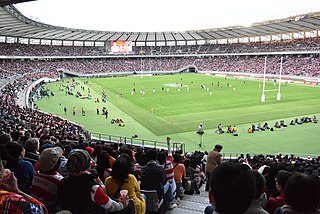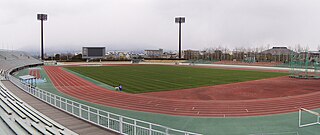This article needs additional citations for verification .(August 2017) (Learn how and when to remove this template message) |
| ベストアメニティスタジアム | |
 | |
| Former names | Tosu Stadium (1996-2007) |
|---|---|
| Location | |
| Coordinates | 33°22′19″N130°31′13″E / 33.37194°N 130.52028°E Coordinates: 33°22′19″N130°31′13″E / 33.37194°N 130.52028°E |
| Public transit | JR Kyushu : Kagoshima Main Line and Nagasaki Main Line at Tosu |
| Owner | City of Tosu |
| Operator | City of Tosu |
| Type | Stadium |
| Capacity | 24,130 |
| Field size | 125 m × 78 m |
| Field shape | Square |
| Surface | Grass |
| Construction | |
| Opened | June 1996 |
| Construction cost | ¥6.7 billion [1] |
| Architect | JGC Corporation [1] |
| Main contractors | Obayashi Corporation [1] |
| Tenants | |
Sagan Tosu (1997-) Tosu Futures (1996) | |
Best Amenity Stadium(ベストアメニティスタジアムBest Amenity Sutajiamu) is a football stadium in Tosu, Saga, Japan. It serves as a home ground of J1 League club Sagan Tosu. The stadium holds 24,130 people and was built in 1996.

A stadium is a place or venue for (mostly) outdoor sports, concerts, or other events and consists of a field or stage either partly or completely surrounded by a tiered structure designed to allow spectators to stand or sit and view the event.

Tosu is a city located in the eastern part of Saga Prefecture on the island of Kyushu, Japan.

Japan is an island country in East Asia. Located in the Pacific Ocean, it lies off the eastern coast of the Asian continent and stretches from the Sea of Okhotsk in the north to the East China Sea and the Philippine Sea in the south.
Contents
It was built in the site of Tosu rail yard and Tosu classification yard in accord with the JR Kyushu's Tosu Station.

A rail yard, railway yard or railroad yard is a complex series of railroad tracks for storing, sorting, or loading and unloading, railroad cars and locomotives. Railroad yards have many tracks in parallel for keeping rolling stock stored off the mainline, so that they do not obstruct the flow of traffic. Railroad cars are moved around by specially designed yard switchers, a type of locomotive. Cars in a railroad yard may be sorted by numerous categories, including railroad company, loaded or unloaded, destination, car type, or whether they need repairs. Railroad yards are normally built where there is a need to store cars while they are not being loaded or unloaded, or are waiting to be assembled into trains. Large yards may have a tower to control operations.
A classification yard or marshalling yard is a railway yard found at some freight train stations, used to separate railway cars onto one of several tracks. First the cars are taken to a track, sometimes called a lead or a drill. From there the cars are sent through a series of switches called a ladder onto the classification tracks. Larger yards tend to put the lead on an artificially built hill called a hump to use the force of gravity to propel the cars through the ladder.

The Kyushu Railway Company, also referred to as JR Kyushu, is one of the constituent companies of Japan Railways Group. It operates intercity rail services in Kyushu, Japan and the JR Kyushu Jet Ferry Beetle hydrofoil service across the Tsushima Strait between Fukuoka and Busan, South Korea. It also operates hotels, restaurants, and drugstores across its service region. JR Kyushu's headquarters are in Hakata-ku, Fukuoka.
It was formerly known as Tosu Stadium(鳥栖スタジアムTosu Sutajiamu). Since January 2008 it has been called Best Amenity Stadium for the naming rights.

Naming rights are a financial transaction and form of advertising whereby a corporation or other entity purchases the right to name a facility or event, typically for a defined period of time. For properties like a multi-purpose arena, performing arts venue or an athletic field, the term ranges from three to 20 years. Longer terms are more common for higher profile venues such as a professional sports facility.














